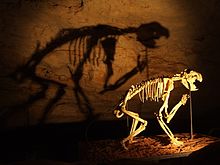Limestone Coast is a region in South Australia. It is a tourist region and a wine zone.
Cities
edit- 1 Keith – just another stopover when going from Melbourne to Adelaide
- 2 Mount Gambier – cave diving capital of Australia, and South Australia's second largest city, just after Adelaide
- 3 Naracoorte – near the UNESCO World Heritage Site of Naracoorte Caves National Park
- 4 Robe – not known for robes but rather its coastline
Other destinations
edit- 1 Canunda National Park – where the limestone cliffs of the Limestone Coast are
- 2 Naracoorte Caves National Park – UNESCO World Heritage Site home to some of the largest collections of mammalian fossils, most which are not seen anywhere outside Australia or New Guinea
Understand
editHistory
editFrom the Victoria border to the Younghusband Peninsula this area has been settled since colonisation by mainly European settlers in the 1840s, displacing an indigenous population that had resided in the region for thousands of years. The region supports farming, viticulture, forestry and tourism. Towns include Bordertown, Keith, Millicent, Mount Gambier, Penola, and Naracoorte and the coastal resorts of Beachport, Kingston SE and Robe.
Geography
editMuch of the Limestone Coast is low-lying, and was inundated by sea as recently as 2 million years ago. It had previously also been flooded 15–20 million years ago. The plains are lined by rows of low sandhills parallel to the coast, created at times when the coastline was at that level. Prior to European settlement, much of the land between the sandhills was swamp fed by streams and subject to inundation. A network of drains totalling 1450 km has been constructed to channel the water away through the sandhills to the ocean. Important areas of wetland remain including the lakes and lagoons such as the southern end of the Coorong and Bool Lagoon. Meanwhile, areas of upland in the Limestone Coast include the volcanic craters of Mount Gambier.
Climate
editThe Mediterranean climate of this coast is cool and moist with wet winters. Generally the only times where it may be considered as "cold" is during a cold-front which happens quite often in winter.
Get in
editBy car
editBy plane
edit- 1 Mount Gambier Airport (MGB IATA) (about 10 minutes from Mount Gambier). REX is the only airline which flies to Mt Gambier from Adelaide. The tickets vary widely in price from $120 to $270.
By bus
editFrom Adelaide, bus tickets for Adelaide can be purchased at the Sir Robert Helpmann Theatre (cash or cheque only) to Mount Gambier. The bus service from Adelaide is run by Premier Stateliner. It can be just as easy to make a phone booking with Premier Stateliner. Thursdays and Fridays you can get from Adelaide to Mt Gambier at 8:15AM or 5:30PM. Sundays the bus leaves Adelaide at 2:45PM. Other days the service leaves at 8:15AM. The bus trip takes about six hours.
By train
editFrom Melbourne, the V-Line service runs Melbourne to Warrnambool on the train, then from Warrnambool to Mt Gambier as a coach service (it also goes via Portland). V-Line services from Mt Gambier are "no reserve", you pay the driver on the day — bring exact change. V-Line services are generally not busy except during school holidays. They run once a day. From Mount Gambier, the coach does go for a little bit around but apart from going to Mount Gambier, there is no other train stations elsewhere.
Get around
editSee
edit
The Limestone Coast is home to South Australia's one and only UNESCO World Heritage Site, Naracoorte Caves National Park full of mammalian fossils which contain the fossils of enormous extinct Australian megafauna such as the marsupial lion, giant kangaroo as well as, which may sound creepy to some; five-metre-long snakes. This was because over the last couple of million years ago, geological processes brought sand and soil into the caves creating thick sedimentary deposits which preserved the remains of the animal living in and around the caves at the time. Up to 20 species of megafauna are preserved at a remarkable level across multiple caves, which all of these make the site is one of the jewels in Australian paleontology.
Do
edit- Cave diving — The part of the region around and including the City of Mount Gambier is famous for its sinkholes and water-filled caves. Extraordinary dives take place in some of these sinkholes but if you intend to do this, make sure you are appropriately trained as this activity has claimed lives in the past. Refer to Diving in South Australia for more information.
Eat
editDrink
editCoonawarra
editCoonawarra, a rural locality on the is synonymous with Cabernet Sauvignon, full of plum and blackcurrant fruit, so much so that successes with other grape varieties is overlooked. In the early days Shiraz was the most widely planted grape, and it produces some star wines such as Wynns Coonawarra Estate Michael Shiraz (formerly Michael Hermitage). The limestone geology also suits Chardonnay, Riesling, and Sauvignon blanc.
Coonawarra has a membership organisation for wineries, the Coonawarra Vignerons Association. Some of the wineries with cellar doors include Wynns Coonawarra Estate. Other wineries who use fruit from the Coonawarra include Yalumba and Penfolds.
Sleep
editStay safe
editCrime isn't generally a problem in the Limestone Coast, and following the normal protocols for what you would normally be doing elsewhere would just do you fine.
As a relatively homogeneous part of Australia, xenophobia exists in the Limestone Coast, though as a tourist, your chances of encountering overt racism are slim.
Go next
edit- Head southeast to the South West Coast of Victoria, or east to the Wimmera region of Victoria
- Head northwest to the Murray & Mallee region of South Australia

